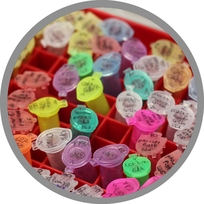Team:LMU-Munich/Abstract
From 2012.igem.org
| Line 5: | Line 5: | ||
<p align="justify"> | <p align="justify"> | ||
| - | We chose to work with | + | We chose to work with <i>Bacillus subtilis</i> to set new horizons and offer tools for this model organism to the <i>Escherichia coli</i>-dominated world of iGEM. Therefore, we created a <b><i>Bacillus</i>B</b>io<b>B</b>rick<b>B</b>ox (<b>B<sup>4</sup></b>) composed of reporter genes, defined promoters, as well as reporter, expression, and empty vectors in BioBrick standard. <i>B. subtilis</i> naturally produces stress-resistant endospores which can germinate in response to suitable environmental conditions. To highlight this unique feature using the <b>B<sup>4</sup></b>, we developed <b>Sporo</b>beads. These are spores displaying fusion proteins on their surface. As a proof of principle, we fused GFP to the outermost layer. Expanding this idea, we designed a <b>Sporo</b>vector to easily create any <b>Sporo</b>bead imaginable. Because the <b>Sporo</b>beads must be biologically safe and stable vehicles, we prevented germination by knocking out involved genes and developed a <b>Suicide</b>switch turned on in case of germination. With the project <b>Bead</b>zillus, our team demonstrates the powerful nature of <i>B. subtilis</i>. |
</p> | </p> | ||
Latest revision as of 16:40, 26 October 2012

The LMU-Munich team is exuberantly happy about the great success at the World Championship Jamboree in Boston. Our project Beadzillus finished 4th and won the prize for the "Best Wiki" (with Slovenia) and "Best New Application Project".
[ more news ]

Beadzillus: Fundamental BioBricks for Bacillus subtilis and spores as a platform for protein display
We chose to work with Bacillus subtilis to set new horizons and offer tools for this model organism to the Escherichia coli-dominated world of iGEM. Therefore, we created a BacillusBioBrickBox (B4) composed of reporter genes, defined promoters, as well as reporter, expression, and empty vectors in BioBrick standard. B. subtilis naturally produces stress-resistant endospores which can germinate in response to suitable environmental conditions. To highlight this unique feature using the B4, we developed Sporobeads. These are spores displaying fusion proteins on their surface. As a proof of principle, we fused GFP to the outermost layer. Expanding this idea, we designed a Sporovector to easily create any Sporobead imaginable. Because the Sporobeads must be biologically safe and stable vehicles, we prevented germination by knocking out involved genes and developed a Suicideswitch turned on in case of germination. With the project Beadzillus, our team demonstrates the powerful nature of B. subtilis.
 "
"





